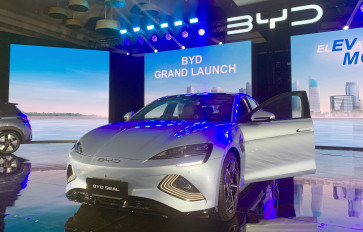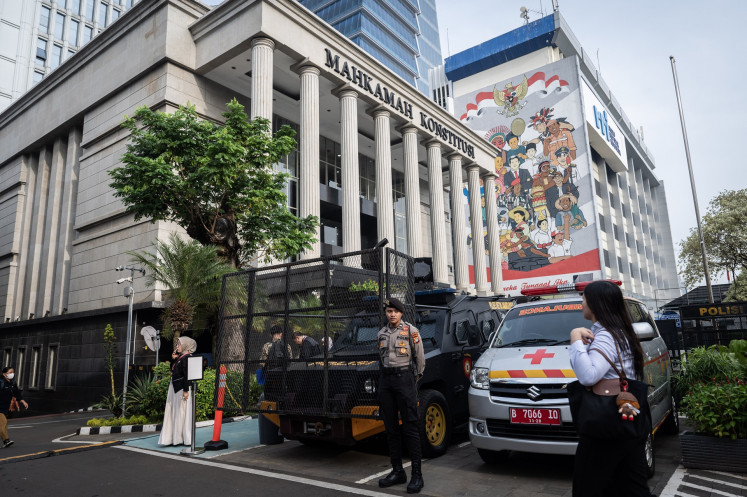The 'valley of death' - barrier to innovation
The "valley of death" refers to the extreme difficulties faced when converting an invention into a successful and concrete application
Change text size
Gift Premium Articles
to Anyone

The "valley of death" refers to the extreme difficulties faced when converting an invention into a successful and concrete application.
A good illustration of the negative consequence of failing to create a concrete application is reflected by a recent report in this newspaper, entitled "LIPI products destined for museum" (The Jakarta Post, Aug. 7, 2008.)
The article stated only four out of 100 of LIPI's technological inventions made it to market in the last five years. LIPI is the Indonesian Institute of Sciences, Indonesia's version of the U.S. National Science Foundation or the Australian Commonwealth Scientific and Industrial Research Organization.
The article went on to explain LIPI's difficulty in commercializing their inventions, namely because of lack of funding and lack of private sector interest.
The valley of death presents problems to all inventions, not just Indonesia's. The two constraints cited are hardly new and can be found in many other countries.
That's good news because it means experience overcoming these problems is plentiful since much effort has been expended to help inventors apply and commercialize their inventions, especially in more advanced countries.
However, before I list what steps the Indonesian government can undertake, it is imperative to understand why the government ought to care.
Innovations, both technological and scientific, have been identified as one of the key ingredients to sustained economic growth and improved social prosperity. This is true regardless of a country's economic stage. Varying technological capabilities is not a disadvantage per se but it does call for different optimal combinations of science and technology.
Even imitation requires the ability to work with an underlying technology. Also, technologies considered practical in some countries may be impractical in others or may require adaptation to local conditions. Such adaptation is only possible when the country possesses at least a basic level of scientific and technological knowledge.
Indonesia's absorptive and inventive capability, as indicated by available inventive performance statistics, actually compares quite favorably to other countries such as the Philippines and Thailand which are at a similar stage of development.
For example, according to a 2007 report by the World Intellectual Property Organization (WIPO Patent Report: Statistics on Worldwide Patent Activity), in 2005, Indonesians filed 17 patents for every million people whereas residents of the Philippines and Thailand filed 2 and 14 patents for every million, respectively.
In fact, Indonesia's productivity in research and development (R&D) -- at 10.6 patents filed per 1 million U.S. purchasing power parity dollars in R&D expenditures -- is higher than that of more advanced Asian and Pacific countries such as Singapore (0.2 patents per US$1 million), China (0.9), Australia (1.0) and Korea (5.1). Indonesia's cost per patent is lower despite the fact Indonesia has fewer patents filed per million US dollars of gross domestic product.
The important question is whether this inventive performance translates into innovative application. How many of those inventions Indonesians produced at much lower cost materialize into valuable commercial products or processes?
These questions bring us back to our original story about the 5 percent commercialization success rate of LIPI's inventions. This is indeed quite low. To compare, the commercialization rate in Korea is more than 40 percent.
The LIPI story demonstrates Indonesia's valley of death is quite wide and most likely requires some concerted government effort to help out Indonesian inventors. Otherwise Indonesia's high R&D productivity has little effect on Indonesia's prosperity.
What should the government do?
The government can support improving market exposure for inventions as well as their actual marketing. The recent LIPI Expo 2008 in which LIPI showcased 100 of its inventions is a step in the right direction except, instead of the exhibition aiming to "measure the performance of LIPI" it should aim to market LIPI inventions.
Furthermore, marketing support should be extended to other inventions in additions to LIPI's. Korea, for example, promoted its inventions through national technology fairs. Administered by the Korea Invention Promotion Association, these fairs help publicize inventions and facilitate intellectual property rights transmission for practical applications, technology transfers, and joint investment.
To support the first step, the Korean government also provides subsidies for assessing an invention's potential value.
Often, individual inventors and potential investors do not have the resources to carry out such assessments.
In Australia, a weekly TV program on the government-funded channel ABC, called The New Inventors, brings recent inventions to a wide audience. Three inventors showcase prototypes of their inventions to a panel of experts who evaluate the originality, design, manufacturing potential, pricing, marketability and other aspects of their creations.
LIPI could enter into a similar agreement with government-supported TVRI or another, private TV channel to create a similar program which could have a positive side effect of promoting public awareness of innovative activities.
The government needs to encourage, subsidize and train to bring about institutional change. Specialized commercialization and application departments within LIPI and other government institutions, as well as within universities, could be bridging mechanisms to help inventors.
Such departments can be tasked with identifying potential commercial partners domestically and overseas.
All of these activities will incur costs. However, such costs will lead to financial rewards which will far more than compensate for the expense.
If the private sector were to spend on innovation some portion of the Rp 40 trillion a year it currently spends on marketing (as opposed to the Rp 51 billion spent for R&D LIPI deputy chair Lukman Hakim said as quoted in the original article) there is definitely ample money in the Indonesian market to reward successfully commercialized innovation.
The writer is a research fellow at the Melbourne Institute of Applied Economic and Social Research and the Intellectual Property Research Institute of Australia, University of Melbourne, Melbourne, Australia.









